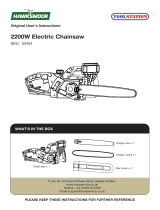POWEG10110 EN
Copyright © 2021 VARO P a g e | 5 www.varo.com
▪ To prevent damage to your hearing, wear earmuffs. Helmets with a visor are particularly
advantageous.
▪ Make sure you have a firm footing when working with the chain saw.
▪ Keep your place of work tidy.
▪ To prevent electric shock, avoid contact with earthed parts.
▪ Always pull the plug out of the power socket before doing any work on the chainsaw.
▪ Only plug in when the chainsaw is switched off,
▪ The chainsaw must be used only by one person at a time. All other persons must stay
clear of the chainsaw’s area of swing. Children and pets in particular must be kept well
away at all times.
▪ The saw must not be touching anything when it starts up.
▪ Hold the chainsaw firmly in both hands when working with it.
▪ The chain saw must not be operated by children and young people. The only exception to
this prohibition are young persons of 16 years and over who can use the chain saw under
supervision as part of their training. Lend the saw only to those persons who are familiar
with this type of chainsaw and know how to handle it. Always pass on the operating
instructions together with the chainsaw.
▪ Make sure the chain saw is stored in a place inaccessible to children.
▪ The saw may be operated only by persons who are rested and in good health, i.e. in a
good physical condition. If you start to tire, have a break in time. The chainsaw should not
be used after the consumption of alcohol.
▪ Never expose the chainsaw to rain or bad weather. Make sure there is enough light at the
place of work. Do not use power tools in the vicinity of combustible liquids or gases.
▪ If the chainsaw is not being used for a while, it must be set aside in such a way that no
other person is endangered.
▪ Before making a cut, always set the claw stop before you start to saw.
▪ Remove the chainsaw from the wood only with the saw chain still running. Anyone who
saws without a stop can be pulled forwards.
▪ Never use the chainsaw when standing on a ladder, in a tree or in any other instable
places. Do not saw with one hand.
▪ The power cable must always be behind the saw operator.
▪ The power cable must always lead away from the rear of the chainsaw.
▪ Use only original accessories.
▪ Chainsaws used outdoors must be connected up to an earth-leakage circuit-breaker.
▪ Do not overload your power tools. They run best and safest within given range of capacity.
▪ Always use the correct power tool. Do not use low-powered chainsaws for heavy jobs.
▪ Use the cable only for its proper purpose. Never carry your electric tool by its cable. Do
not use the cable to pull the plug out of the socket. Protect the cable from heat, oil and
sharp edges.
Extension cables out doors
▪ Use only authorized and accordingly labelled extension cables out of doors.
▪ Use a strong support when sawing converted timber and thin branches (saw-horse, Fig.
7b). Do not stack the timber and do not have it held by a second person or with your foot.
▪ Logs must be secured in position.
▪ On sloping ground, always work facing upwards.
▪ When cross-cutting always set the claw stop against the timber you want to saw (see Fig.
7b)
▪ Always set the claw stop before cross-cutting. Only then switch on the chainsaw and start
sawing into the wood. Pull the chainsaw upwards at the rear and lead the direction with
the front grip. Use the claw stop as a fulcrum. To reposition for further cutting, interrupt the
sawing process and exert a slight pressure on the front grip. Pull the saw back a little,
position the claw stop further down the cut and pull up the rear grip (see Fig. 7a).
▪ Pull the saw out of the wood only when the saw chain is running.
▪ If you carry out several cuts, switch off the chain saw in-between.

















